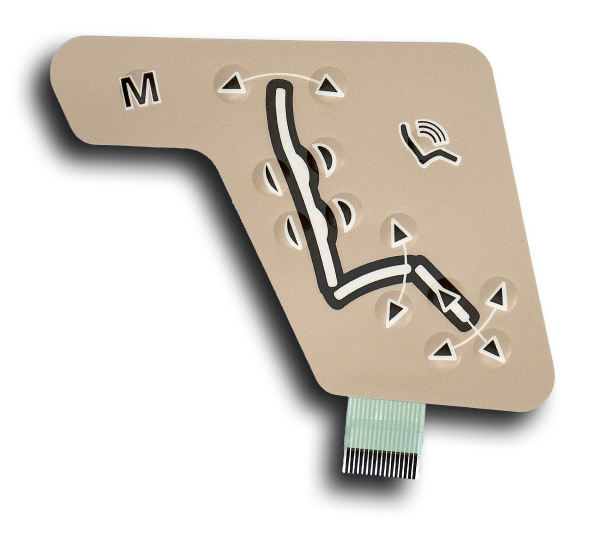Understanding Membrane Switches Over: The Secret to Resilient and Dependable Controls

What Are Membrane Layer Switches?
Membrane buttons are an innovative option in the world of user interface innovation, incorporating capability and layout perfectly. These tools work as an interface between users and electronic systems, integrating a number of parts right into a portable format. Generally built from versatile, slim layers of products, membrane layer buttons are created to react to touch, making it possible for customers to interact with machinery and electronic devices effectively.
The primary elements of a membrane button consist of a printed circuit layer, graphic overlay, and a spacer layer that avoids unplanned activation. The visuals overlay can be tailored to mirror brand name identity or individual choices, boosting visual appeals while guaranteeing usability. Membrane buttons are frequently utilized in various applications, consisting of clinical devices, consumer electronic devices, and commercial equipment, owing to their resilience and resistance to environmental variables such as dampness and dust.
One of the crucial advantages of membrane buttons is their capability to withstand damage, making them excellent for high-traffic environments. In addition, they are lightweight and require marginal area, enabling cutting-edge styles in product growth. Generally, membrane changes represent a reliable and useful choice for contemporary electronic interfaces, weding innovation with user-centric layout principles.
Just How Membrane Switches Over Job
The operation of membrane switches over hinges on an easy yet reliable mechanism that equates individual input into digital signals. When a customer presses the switch, the leading layer flaws, permitting a conductive element in the circuit layer to make call with a matching conductive pad on the underside of the graphic overlay.
The design of membrane buttons can vary, but they usually incorporate domes or tactile aspects to give responses to the individual, boosting the total experience - membrane switch. The materials used in membrane switches, such as polyester or polycarbonate, contribute to their sturdiness and resistance to ecological aspects, including wetness and dust. Moreover, the published circuits are normally enveloped, which shields them from damage over time.
Advantages of Membrane Layer Buttons

Additionally, membrane switches are known for their longevity. Constructed from robust materials, they are resistant to dust, moisture, and physical wear, which considerably prolongs their lifespan contrasted to traditional mechanical buttons. This sturdiness makes them especially ideal for high-traffic settings and applications calling for long life.
An additional substantial advantage is the simplicity of cleaning and maintenance. The smooth surface area of membrane layer switches over lessens dirt buildup and is find here typically unsusceptible spills, making them excellent for settings that need regular sanitization.
Furthermore, membrane switches supply a structured account, leading to a thinner design that can be incorporated right into different gadgets without adding mass. This function not only boosts the visual charm but also adds to a more ergonomic item style.
Applications of Membrane Switches
Functional and easy to use, membrane layer buttons find applications throughout a large variety of industries, consisting of medical devices, customer electronics, and commercial devices. In the medical area, these switches are integral to devices such as diagnostic equipment, person tracking systems, and mixture pumps, where reliability and ease of cleansing are important. Their ability to keep and endure rough atmospheres capability makes them optimal for such applications.

In customer electronics, membrane layer switches are utilized in items like microwaves, washing devices, and remotes - membrane switch. Their streamlined layout enables user-friendly interface, improving the total individual experience while giving toughness and resistance to tear and use
Commercial tools also profits from membrane switches, specifically in control panels for equipment and automation systems. These switches provide security versus dust and wetness, ensuring constant performance in difficult settings. Furthermore, their customizable attributes permit manufacturers to tailor them to particular functional requirements, improving effectiveness and functionality.
Selecting the Right Membrane Change
When choosing a membrane button, it is vital to take into consideration numerous variables that affect efficiency and viability for details applications. The key factors to consider consist of linked here environmental conditions, tactile responses, sturdiness, and style specifications.
First, assess the operating setting; buttons revealed to wetness, chemicals, or extreme temperature levels require specific products to make certain durability and functionality. Next, examine the need for responsive comments. Depending upon user communication, some applications may take advantage of a tactile feedback to verify activation, while others may prefer a non-tactile style for aesthetic factors.
Resilience is another essential aspect; membrane buttons must be developed to endure regular use, influences, and abrasion. Guarantee the selected button can endure the anticipated lifecycle, particularly in high-usage circumstances.

Verdict
In verdict, membrane changes serve as vital elements in the layout of reputable and sturdy control systems throughout numerous sectors. The versatility of membrane changes permits for customized solutions that fulfill particular functional demands, strengthening their importance in modern innovation.
Membrane layer switches represent a vital element of contemporary user interface style, blending capability with durability in different applications.Membrane switches are an advanced service in the realm of user interface technology, incorporating capability and layout perfectly. Normally created from adaptable, slim layers of products, membrane layer buttons are made to respond to touch, allowing individuals to communicate with machinery and electronic devices effectively.
The design of membrane switches can differ, but they typically integrate domes or tactile aspects to offer responses to the customer, boosting the general experience.In final thought, membrane switches offer as crucial parts in the layout of sturdy and reliable control systems throughout numerous markets.